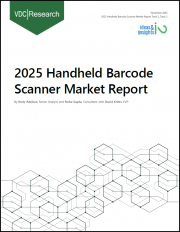
|
시장보고서
상품코드
1622069
세계의 바코드 디코더 시장 규모 : 제품 유형별, 기술별, 용도별, 지역별, 범위 및 예측Global Barcode Decoders Market Size By Product Type, By Technology, By Application, By Geographic Scope and Forecast |
||||||
바코드 디코더 시장 규모 및 예측
바코드 디코더 시장 규모는 2023년 3억 7,000만 달러로 평가되며 2024년부터 2031년까지 6.6%의 CAGR로 2031년에는 5억 1,000만 달러에 달할 것으로 예측됩니다. 바코드 디코더에 대한 수요는 제조, 물류, 소매, 의료 등 많은 산업에서 자동화 추세가 강화되고 있는 배경에 기인합니다. 이러한 도구는 데이터 수집을 자동화하고 절차를 간소화하여 생산과 효율성을 향상시키는 데 필수적입니다.
바코드 디코더 세계 시장 촉진요인
바코드 디코더 시장의 촉진요인은 다양한 요인에 의해 영향을 받을 수 있습니다.
자동화 확산:
바코드 디코더에 대한 수요는 제조, 물류, 유통, 소매, 의료 등 다양한 산업에서 자동화 추세가 증가함에 따라 증가하고 있습니다. 이러한 도구는 데이터 수집을 자동화하고 절차를 간소화하여 생산과 효율성을 향상시키는 데 필수적입니다.
재고 관리의 중요성
바코드 디코더는 이를 위해 필요한 도구입니다. 기업이 공급망을 간소화하고 상품 보관 비용을 절감하기 위해 고급 바코드 디코딩 솔루션의 필요성이 증가하고 있습니다.
기술의 진보:
바코드 디코딩 기술의 발전에는 스캔 능력 향상, 고성능 디코딩 알고리즘, 기업 자원 계획(ERP) 소프트웨어와 같은 다른 시스템과의 상호 작용 등이 포함됩니다. 이러한 기술 발전은 속도, 정확성 및 신뢰성을 향상시켜 바코드 디코더를 사용할 수 있는 분야를 넓히고 있습니다.
E-Commerce 활동의 증가:
바코드 디코더에 대한 수요는 전 세계 E-Commerce 산업의 급격한 성장으로 인해 생겨났습니다. 이러한 가젯은 물류 센터 및 E-Commerce 창고의 재고 관리, 배송 모니터링 및 주문 처리에 필수적입니다.
규제 준수 요건:
바코드 기술은 의료, 제약, 식품 및 음료 등의 분야에서 엄격한 규제로 인해 제품 식별 및 추적성을 위해 바코드 기술이 요구되고 있습니다. 다양한 산업 분야에서 바코드 디코더의 사용은 의약품 공급망 보안법(DSCSA) 및 FDA의 고유 장치 식별(UDI)과 같은 법률 준수에 의해 촉진되고 있습니다.
높아지는 추적 솔루션 니즈:
제품 추적성 및 위조 방지 대책에 대한 관심이 높아지면서 바코드 기술을 활용한 추적 솔루션에 대한 요구가 증가하고 있습니다. 바코드 디코더는 제조부터 유통, 소매에 이르기까지 공급망의 모든 단계에서 정확하고 효과적인 제품 추적을 가능하게 합니다.
비용 효율적인 솔루션:
RFID(Radio Frequency Identification)와 같은 다른 기술에 비해 바코드 디코딩 기술은 데이터 캡처 및 식별을 위해 더 저렴한 옵션을 제공합니다. 바코드 디코더는 이러한 비용 효율성으로 인해 많은 산업 분야에서 널리 사용되고 있습니다.
바코드 디코더 세계 시장 억제요인
바코드 디코더 시장에는 몇 가지 요인이 억제요인으로 작용할 수 있습니다. 여기에는 다음과 같은 것들이 포함됩니다.
호환성 문제:
호환성 문제: 바코드 디코더는 기업이 현재 사용 중인 장비 및 소프트웨어와 통합하기 어려울 수 있습니다. 구식 시스템이나 불일치하는 바코드 형식과의 복잡한 통합은 산업 확장 및 채택을 방해할 수 있습니다.
보안 우려 사항:
바코드 기술이 많은 기업에 보급되면서 데이터 보호 및 위조 방지와 관련된 보안 문제가 대두되고 있습니다. 기업들은 바코드 데이터에 대한 무단 액세스와 바코드 라벨 위조 등으로 인한 공급망 무결성 및 고객 안전에 대한 위험 때문에 바코드 디코딩 솔루션의 전면적인 사용을 꺼려하고 있습니다.
바코드의 가독성 제한:
먼지가 많거나 어두운 창고와 같은 열악한 환경에서는 바코드 디코더가 깨진 바코드나 잘못 쓰여진 바코드를 해독하는 데 어려움을 겪을 수 있습니다. 이러한 제한은 데이터 캡처의 정확성과 신뢰성에 영향을 미칠 수 있으며, 이는 고객 만족도와 업무 효율성에 영향을 미칠 수 있습니다.
높은 초기 비용:
많은 기업, 특히 중소기업(SME)의 경우, 하드웨어, 소프트웨어 및 구현 비용을 포함하여 바코드 디코딩 시스템을 도입하는 데 필요한 초기 비용이 상당할 수 있습니다. 특히 투자 수익률(ROI)이 불분명한 경우, 초기 비용이 높다고 인식되어 바코드 디코딩 시스템 도입을 망설일 수 있습니다.
대체 기술로부터의 위협:
바코드 기술은 여전히 널리 사용되고 있지만 일부 응용 분야에서는 대체 기술이 점점 더 널리 사용되고 있습니다. 이러한 기술의 예로는 RFID와 NFC가 있습니다. 이러한 기술 혁신은 데이터 저장 용량, 판독 범위 확대, 실시간 추적 등의 이점을 제공함으로써 바코드 디코더 시장을 압박하고 있습니다.
규제 준수에 대한 어려움:
바코드 기술의 성장은 산업별로 규제 준수에 기인하는 경우가 많지만, 기업들은 많은 규제를 극복하는 것이 어렵다고 느낄 수 있습니다. 제품 식별 및 라벨링에 대한 GS1 표준과 같은 산업별 표준 및 규제를 따라야 하는 경우 바코드 디코딩을 구현하는 것이 더욱 어려워집니다. 이러한 표준과 규정은 기술 및 프로세스 최적화에 대한 지속적인 투자를 요구합니다.
벤더 인클로저와 시장 파편화:
다양한 상품과 서비스를 제공하는 수많은 공급업체들이 세계 바코드 디코더 시장을 정의하고 있습니다. 업계의 단편화는 기업이 지속적인 유지보수 및 업그레이드를 위해 특정 공급업체에 의존하게 되면서 상호운용성 및 공급업체 종속성 문제를 야기할 수 있습니다.
목차
제1장 소개
- 시장 정의
- 시장 세분화
- 조사 방법
제2장 주요 요약
- 주요 조사 결과
- 시장 개요
- 시장 하이라이트
제3장 시장 개요
- 시장 규모와 성장의 가능성
- 시장 동향
- 시장 성장 촉진요인
- 시장 성장 억제요인
- 시장 기회
- Porter's Five Forces 분석
제4장 바코드 디코더 시장 : 제품 유형별
- 핸드헬드 바코드 디코더
- 고정 마운트형 바코드 디코더
- 휴대용/Bluetooth 바코드 디코더
- 웨어러블 바코드 디코더
제5장 바코드 디코더 시장 : 기술별
- 레이저 스캐너
- CCD(전하결합소자) 스캐너
- 영상 스캐너
- 전방향 스캐너
제6장 바코드 디코더 시장 : 용도별
- 소매·소비재
- 헬스케어
- 제조·산업
- 운송·물류
제7장 지역 분석
- 북미
- 미국
- 캐나다
- 멕시코
- 유럽
- 영국
- 독일
- 프랑스
- 이탈리아
- 아시아태평양
- 중국
- 일본
- 인도
- 호주
- 라틴아메리카
- 브라질
- 아르헨티나
- 칠레
- 중동 및 아프리카
- 남아프리카공화국
- 사우디아라비아
- 아랍에미리트
제8장 시장 역학
- 시장 성장 촉진요인
- 시장 성장 억제요인
- 시장 기회
- COVID-19의 시장에 대한 영향
제9장 경쟁 구도
- 주요 기업
- 시장 점유율 분석
제10장 기업 개요
- Datalogic
- Symbol Technologies(Zebra)
- Honeywell
- Cognex
- SICK
- Newland NCR
- Denso Wave
- Microscan
- Opticon Sensors
- MINDEO
- Zebex
- CipherLAB
- Bluebird
- Argox(SATO)
- SUNLUX IOT
제11장 시장 전망과 기회
- 신기술
- 향후 시장 동향
- 투자 기회
제12장 부록
- 약어 리스트
- 정보 출처와 참고문헌
Barcode Decoders Market Size And Forecast
Barcode Decoders Market size was valued at USD 370 Million in 2023 and is projected to reach USD 510 Million by 2031, at a CAGR of 6.6% from 2024 to 2031. The need for barcode decoders is being driven by the growing trend of automation in a number of industries, including manufacturing, logistics, retail, and healthcare. These tools are essential for automating data collection and simplifying procedures, which increases production and efficiency.
Global Barcode Decoders Market Drivers
The market drivers for the Barcode Decoders Market can be influenced by various factors. These may include:
Growing Automation Adoption:
The need for barcode decoders is being driven by the growing trend of automation in a number of industries, including manufacturing, logistics, retail, and healthcare. These tools are essential for automating data collection and simplifying procedures, which increases production and efficiency.
Inventory management is becoming:
more and more important, and barcode decoders are a necessary tool for this. There is an increasing need for sophisticated barcode decoding solutions as companies work to streamline their supply chains and reduce the expense of keeping goods on hand.
Technological Advancements:
The market is growing as a result of ongoing developments in barcode decoding technology, which include improved scanning capabilities, high-performance decoding algorithms, and interaction with other systems like enterprise resource planning (ERP) software. These technical advancements increase speed, precision, and dependability, increasing the range of sectors in which barcode decoders can be used.
Growing E-Commerce Activity:
The need for barcode decoders is being driven by the global e-commerce industry's exponential growth. These gadgets are essential for distribution centers and e-commerce warehouses' inventory management, shipment monitoring, and order fulfillment procedures.
Regulatory Compliance Requirements:
Barcode technology is required for product identification and traceability due to strict regulations in areas including healthcare, pharmaceuticals, and food and beverage. The use of barcode decoders in various industries is fueled by adherence to laws like the Drug Supply Chain Security Act (DSCSA) and the FDA's Unique Device Identification (UDI).
Growing Need for Track and Trace Solutions:
The need for track and trace solutions, which mostly rely on barcode technology, is being driven by the growing emphasis on product traceability and anti-counterfeiting measures. Accurate and effective product tracking is made possible by barcode decoders at every stage of the supply chain, from manufacturing to distribution to retail.
Cost-Effective Solution:
Compared to other technologies like RFID (Radio Frequency Identification), barcode decoding technology provides a more affordable option for data capture and identification. Barcode decoders are widely used in many industries due in large part to this cost benefit.
Global Barcode Decoders Market Restraints
Several factors can act as restraints or challenges for the Barcode Decoders Market. These may include:
Compatibility Issues:
Barcode decoders may encounter difficulties integrating with the gear and software that businesses now use. Complicated integration with outdated systems or mismatched barcode formats might impede industry expansion and adoption.
Security Concerns:
As barcode technology has spread throughout a number of businesses, security issues pertaining to data protection and preventing counterfeiting have surfaced. Businesses are reluctant to fully use barcode decoding solutions due to the hazards of supply chain integrity and customer safety posed by unauthorized access to barcode data or tampering with barcode labels.
Limited Barcode Readability:
In demanding situations like dusty or dimly lit warehouses, barcode decoders may have trouble deciphering broken or badly written barcodes. This restriction may have an influence on data capture accuracy and dependability, which may have an effect on customer satisfaction and operational effectiveness.
High Initial expenditure:
For many firms, especially small and medium-sized enterprises (SMEs), the initial expenditure needed to adopt barcode decoding systems, including hardware, software, and implementation costs, can be substantial. Organizations may be discouraged from implementing barcode decoding systems due to the perceived high initial expenses, particularly if they are uncertain about the possible return on investment (ROI).
Threat from Alternative Technologies:
Although barcode technology is still widely used, alternative technologies are becoming more and more popular in some applications. Examples of these technologies are RFID and NFC. These innovations put pressure on the market for barcode decoders by providing benefits including data storage capacity, extended read ranges, and real-time tracking.
Regulatory Compliance Difficulties:
Although barcode technology growth is mostly driven by regulatory compliance in some industries, firms may find it difficult to navigate the many regulations. Barcode decoding implementations get more difficult when industry-specific standards and regulations, like the GS1 standards for product identification and labeling, are followed. These standards and regulations demand constant investment in technology and process optimization.
Vendor lock-in and market fragmentation:
A large number of suppliers providing a variety of goods and services define the worldwide barcode decoders market. The fragmentation of the industry can result in problems with interoperability and vendor lock-in, as companies become reliant on particular providers for continuous maintenance and upgrades, so restricting their capacity to innovate and be flexible.
Global Barcode Decoders Market Segmentation Analysis
Global Barcode Decoders Market is segmented based on Product Type, Application, End-User Industry And Geography.
Barcode Decoders Market, By Product Type
- Handheld Barcode Decoders:
- Portable devices designed for manual scanning of barcodes, offering flexibility and mobility for various applications.
- Fixed-Mount Barcode Decoders:
- Stationary units installed in fixed positions, commonly used in retail checkout counters and automated production lines for high-volume scanning.
- Portable/Bluetooth Barcode Decoders:
- Compact devices with Bluetooth connectivity, enabling wireless data capture and mobility for on-the-go scanning tasks.
- Wearable Barcode Decoders:
- Hands-free barcode decoding solutions integrated into wearable devices such as smart glasses or wristbands, ideal for industries requiring constant movement and accessibility.
Barcode Decoders Market, By Technology
- Laser Scanners:
- Utilize laser beams to read barcode data, offering long-range scanning capabilities suitable for industrial environments and large retail spaces.
- CCD (Charge-Coupled Device) Scanners:
- Employ CCD sensor technology to capture barcode images, providing high-resolution scanning suitable for small and medium-sized businesses.
- Imaging Scanners:
- Use image-based technology to capture and decode barcodes, offering versatility and reliability for various barcode types and conditions.
- Omni-Directional Scanners:
- Feature multiple scanning angles for quick and efficient reading of barcodes from any orientation, ideal for high-speed retail checkout and logistics operations.
Barcode Decoders Market, By Application
- Retail and Consumer Goods:
- Used for inventory management, point-of-sale transactions, and product tracking in retail stores and e-commerce warehouses.
- Healthcare:
- Employed for medication administration, patient identification, and inventory control in hospitals, pharmacies, and healthcare facilities.
- Manufacturing and Industrial:
- Facilitate product traceability, quality control, and inventory tracking in manufacturing plants and industrial settings.
- Transportation and Logistics:
- Enable efficient package tracking, sorting, and delivery management in logistics and transportation operations, including warehouses, distribution centers, and shipping facilities.
Barcode Decoders Market, By Geography
- North America:
- Market conditions and demand in the United States, Canada, and Mexico.
- Europe:
- Analysis of the Barcode Decoders Market in European countries.
- Asia-Pacific:
- Focusing on countries like China, India, Japan, South Korea, and others.
- Middle East and Africa:
- Examining market dynamics in the Middle East and African regions.
- Latin America:
- Covering market trends and developments in countries across Latin America.
Key Players
- The major players in the Barcode Decoders Market are:
- Datalogic
- Symbol Technologies (Zebra)
- Honeywell
- Cognex
- SICK
- Newland NCR
- Denso Wave
- Microscan
- Opticon Sensors
- MINDEO
- Zebex
- CipherLAB
- Bluebird
- Argox (SATO)
- SUNLUX IOT
1.Introduction
- Market Definition
- Market Segmentation
- Research Methodology
2.Executive Summary
- Key Findings
- Market Overview
- Market Highlights
3.Market Overview
- Market Size and Growth Potential
- Market Trends
- Market Drivers
- Market Restraints
- Market Opportunities
- Porter's Five Forces Analysis
4.Barcode Decoders Market, By Product Type
- Handheld Barcode Decoders
- Fixed-Mount Barcode Decoders
- Portable/Bluetooth Barcode Decoders
- Wearable Barcode Decoders
5.Barcode Decoders Market, By Technology
- Laser Scanners
- CCD (Charge-Coupled Device) Scanners
- Imaging Scanners
- Omni-Directional Scanners
6.Barcode Decoders Market, By Application
- Retail and Consumer Goods
- Healthcare
- Manufacturing and Industrial
- Transportation and Logistics
7. Regional Analysis
- North America
- United States
- Canada
- Mexico
- Europe
- United Kingdom
- Germany
- France
- Italy
- Asia-Pacific
- China
- Japan
- India
- Australia
- Latin America
- Brazil
- Argentina
- Chile
- Middle East and Africa
- South Africa
- Saudi Arabia
- UAE
8.Market Dynamics
- Market Drivers
- Market Restraints
- Market Opportunities
- Impact of COVID-19 on the Market
9.Competitive Landscape
- Key Players
- Market Share Analysis
10.Company Profiles
- Datalogic
- Symbol Technologies (Zebra)
- Honeywell
- Cognex
- SICK
- Newland NCR
- Denso Wave
- Microscan
- Opticon Sensors
- MINDEO
- Zebex
- CipherLAB
- Bluebird
- Argox (SATO)
- SUNLUX IOT
11.Market Outlook and Opportunities
- Emerging Technologies
- Future Market Trends
- Investment Opportunities
12.Appendix
- List of Abbreviations
- Sources and References"



















